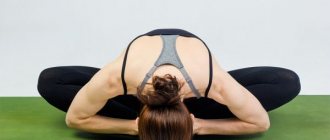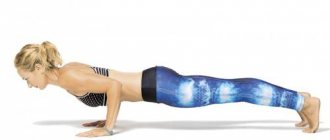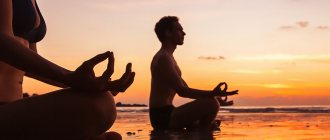Participatory yoga is especially popular among young people today. Such activities help you develop harmoniously as a couple, keep yourself in the necessary physical shape, and also find harmony with the world around you. Paired yoga dates back to ancient times - it is based on the traditions of tantra and some areas of Taoist practice.
Yoga for two is a traditional hatha yoga practice involving two partners. Classes help you learn to relax, trust your partner, and also open up to him. Most couples after this practice claim that their relationships become much better, and a deeper spiritual connection appears between them.
A yoga pair is one of the interesting ways to attract your partner to sports and instill in him a love for a healthy lifestyle.
The paired yoga style has a number of useful skills:
- removes energy blocks and clamps;
- removes any barriers in communication with a partner;
- helps develop trust in relationships;
- improves the art of interacting with people;
- reveals new qualities in relationships - tenderness, openness, firmness, sensuality.
Organization and holding
Three groups of people are usually involved in the challenge process:
- Sponsors are representatives of companies who advertise their products in order to increase demand and increase the attention of potential customers to their company or product.
- The organizers (hosts) are experienced followers of spiritual practice. Develop tasks for participants.
- Participants are people who perform assigned tasks.
The process of creating a yoga challenge, as a rule, has one structure. The organizer prepares the task and instructions for its implementation. The participant implements the idea, based on instructions and assignments, and posts the result captured in a photo or video on the Internet. Sponsors are responsible for rewarding the winning participant.
Also on YouTube, many content creators make yoga challenge videos as an entertainment video. This call can be a group call or a single call. The participant films a video of the performance of an asana selected from a photograph, then uploads it to the channel. This is a simpler challenge format, however, some physical training is required to participate.
Who is couples yoga suitable for?
The practice of couples yoga is suitable for those who want to open up more, relax and trust the outside world. Couples yoga improves relationships and is beneficial for both spouses, parents and children.
It’s not for nothing that yoga for two is called lazy yoga - it has no contraindications.
What you need to do couples yoga
The main advantage of the style is the ability to practice at home with a minimum amount of equipment: blocks, rollers, balls, tapes, etc. You only need a mat. It is also very important to create a comfortable and relaxing atmosphere. To do this, choose a spacious and bright room. To abstract yourself as much as possible from the world around you, turn on a meditative selection. The selection of clothing is also important. Pay attention to comfortable equipment that will not restrict your movements.
How many participants can there be?
Types of yoga challenges are identical to the areas of yogic practices:
- solo yoga;
- steam yoga;
- yoga for three.
Now, in addition to the classical directions, yoga for children has appeared, which can also be paired or solo. There are separate yoga challenges for children.
When choosing one type or another, it is important to take into account the level of trust of partners, practice experience and physical fitness.
Yoga poses for 2. What are the benefits?
Doing yoga with your husband/wife, brother/sister or boyfriend/girlfriend will increase the level of trust in your relationship!
You probably know the benefits of asana practice. If not, we recommend that you read this article.
In addition to these benefits, practicing yoga together allows you to:
- Go deeper into the pose. What you cannot do on your own, your partner will help you do. You will be able to go deeper into the asana and work your muscles better.
- Connect the “sleeping” muscles. Paired acro-yoga asanas develop balance. They activate those muscles that are not used when performing classical asanas.
- Get closer to your partner. Joint practice increases the level of trust between partners. And if some element doesn’t work out the first time... You can laugh at the difficulties. And rejoice when the difficult pose finally works out.
Exercises
Yoga practitioners, as a rule, are divided into three groups :
- beginners;
- people with good physical fitness;
- professionals.
Exercises are developed individually for each group.
For newbies
The simplest and most accessible asanas at all levels of training are considered to be:
Double breathing . Partners sit sitting, leaning on their backs. The first participant takes a slow deep breath, the second, synchronously with him, exhales smoothly. The duration of breathing practice is from three to five minutes on average. The main task is to concentrate on your partner, feel him and not disrupt the breathing rhythm throughout the entire practice.
Entwining your partner . Take a lotus position with your backs touching each other. From this position, stretch up and make a smooth turn over your left shoulder towards your partner. The left hand falls on the partner’s right knee, the right hand rests on his left knee. Stay in this figure for five to six breathing cycles. Then take the lotus position again. Each action should reflect the partner’s action, like a mirror.
Double dog . One partner does Downward-Facing Dog, the second stands on his hands and places his left and right feet alternately on his lower back. After completing 5-6 breathing cycles, switch places.
Triangle . Standing position, back to back, legs spread wide. With your left hand, try to reach your right foot, place your hand next to it. Raise your right one up so that your arms line up in a straight vertical line.
For physically fit people
Complex set of exercises:
Seated tilt towards the feet . Take a sitting position with straight legs. Lean your body forward as much as possible. Meanwhile, your partner should carefully position themselves in a lying position on your back.
Legendary meditation course without payment We recommend! The most popular meditation course for beginners in Russian. More than 100 thousand people have already learned to meditate. Try it yourself. Read more.
Boat . Sitting face to face. Hold hands. Open your legs as wide as possible and lift them simultaneously, continuing to hold hands.
Tilts . Sit opposite each other. Straighten your legs so that your feet are touching. Hold your hands, trying not to bend your knees.
For professionals
For experienced practitioners or people with strong stretching, it is suggested to perform the asanas listed below:
Dandasana. One person sits on the floor with their legs spread wide apart. The second, standing near the knees of the person sitting, rests his hands on his knees, and places his legs on his hands. The participant holding the legs slowly raises their arms until they are fully extended. The final result should be a square shape.
Floating Bow . One participant, lying on his back, raises his legs bent at the knees. His partner, standing with his back, gently rests his buttocks on his feet. Next, the person in a sitting position smoothly raises his legs. It is important for the soarer to relax and maintain balance.
Cobra. One participant lies on the floor, stomach down. The second person places his feet at the level of the thighs of the person lying down, takes the hands of the first participant and bends back. As a result, the person lying down must perform the “Cobra” asana.
Each of the listed asanas should be performed synchronously or alternately. The time required to perform the figure is from four to six breathing cycles, that is, an approximate time of 3-5 minutes. All movements are performed smoothly, without sudden movements, to avoid injuries during the yoga challenge.
Peculiarities
This practice helps build trust with your partner, as well as achieve harmony with your body and emotions. A yoga challenge for two can be called acroyoga and trust yoga. The yoga challenge for two involves you learning to trust and support both at the level of body and spirit.
Where to start? First of all, it’s worth studying the training pictures: a yoga challenge for two always starts with theory. Do not lose sight of the fact that to engage in this type of practice you will need comfortable clothes that do not hinder your movements. Your body needs to breathe, so choose clothes made from organic materials. If you study the pictures and photos, a yoga challenge for two almost always involves the presence of two mats, which can be combined into one to perform paired exercises. If you decide to practice a yoga challenge for two, the poses in the pictures will undoubtedly be useful to you. After studying them, you will be able to perform simple poses even at home.
Use music to relax. A yoga challenge for 2 people is best performed with relaxing music, for example, the sounds of nature or classical music. You can also use mantras to make your movements relaxed.
A person tends not to monitor his breathing while performing asanas, however, breathing is one of the fundamental elements in this practice. People who decide to engage in paired exercises should focus on breathing when performing asanas at least at first. If this seems difficult to you, we recommend taking a couple of lessons with a professional trainer.
Images
Here are more photos of the yoga challenge poses.
Poses for 3 people:
What is couples yoga
The direction of yoga has existed for centuries, which has led to the formation of many movements and styles. Steam room yoga is one of them. The direction is based on hatha yoga, which has significantly transformed into a new exciting direction. Asanas, vinyasas and breathing exercises received a new interpretation. A couple or even 3-4 people can be involved in this type of practice.
Often, by mistake, the opinion arises that studying is only with a loved one. However, you can invite a friend or good acquaintance for classes. Also, involving a third person helps to diversify the classes and complicate the performance of asanas. During classes, proper breathing occupies a special place; it should be synchronous.
After performing a yoga pose together, there should be no feeling of discomfort or pain. During classes, it is very important to observe and feel not only your sensations, but also to understand your partner. This sport often replaces a session with a psychotherapist, while also providing a positive effect on the muscles of the body.
For whom and what is it?
All positions are carried out with mutual support and bring people together through:
- general movement;
- awareness;
- mood;
- breath;
- touch and intimacy.
Yoga poses for two can be done by any two people and this is a great way to:
- strengthen relationships;
- trust, improve communication, create space for discovery and patience;
- carry out gentle stretching, especially of the spinal muscles, through mutual assistance in performing asanas;
- liberating the body from physical and emotional stress;
- seeking mutual balance and concentration;
- understand each other's needs.
Paired yoga even presupposes very close contact.
Paired yoga itself is very individual, it is a personal, internal process. How can it exist in pairs?
Yes, yoga for two is real, there are many videos demonstrating positions where two people participate in yoga poses.
Today, the definition of practice extends to the boundaries of commodity:
- developed yoga of the spine;
- yoga of the face, eyes;
- acro-yoga, etc.
This is the easiest way to feel, understand and describe what is happening to the body and mind. The history of yogis begins with the work of the body. It makes sense to talk about the most subtle form of energy only when you feel at ease and relaxed.
Physical contact is a necessary condition for such practice. Touch is a communication tool. Without this there is no partnership. Practice on separate mats, then this is for two, not two partners.
Downward Facing Dog/Child's Pose (Adho Mukha Svanasana/Balasana)
These are two of the most popular yoga poses for stretching the entire body. They are great to do in tandem with a partner, as you can help each other strengthen the stretch.
Execution technique: one of the partners takes a child's pose with knees spread to the sides and big toes touching. Your knees should be at least hip-width apart and your arms should be extended forward and shoulder-width apart.
He then wraps his arms around the ankles of the partner facing him. The standing partner steps back until the other partner's elbows leave the ground and he feels the sides of the body, shoulders and arms stretch.
The standing partner then leans forward at the hips and places their hands on the seated partner's pelvis (if the hamstring stretch is too strong, the standing partner can bend their knees slightly). Hands should rest on the pelvis, and not on the lower back. It is acceptable for the standing partner to lightly shift his body weight onto his hands, gently massaging the seated partner's pelvis.
Take five to six deep breaths in this position, providing feedback to each other to awaken intimacy and trust. To exit the pose, the standing partner bends his knees and transfers his body weight to his heels, then straightens up.
Seated Cat-Cow Pose (Marjariasana/Bidalasana)
Cat-cow pose is essentially two yoga poses that follow one another in sequence. This pose stretches the muscles of the hips, core and back very well. Cat-cow pose also helps open up your lungs and chest, so remember to focus on your breathing during this exercise.
Technique: Stay in a sitting position and grasp each other's forearms. Lower your shoulders down and move them back without releasing your arms. As you inhale, lift your chest up and bend your thoracic spine. As you exhale, press your chin to your chest, rounding your thoracic spine and spreading your shoulder blades wide.
Continue the exercise for several breathing cycles. When the spine is warmed up, you can raise your gaze to the ceiling as you inhale and lower it to your navel as you exhale. Do 10-12 repetitions, feeling the thoracic spine release, allowing your partner to hold you and thus developing greater trust in him.
Yoga challenge for children
Many parents involve their children in sports from an early age. A yoga challenge for two for children or for one child has the following goals: it helps to unite the family around one goal, has a positive effect on the health and flexibility of the body and promotes the socialization of the child. The yoga challenge should be presented as a game, for example, you can depict animal poses or repeat the image of objects. If you choose simple exercises, even children under three years old can participate in the action.
Centering and grounding while sitting on the floor
Centering and grounding are a great start to any yoga practice. This helps you focus on your spiritual state and physical sensations and prepares your mind for subsequent practice. Mindset and meditation are important aspects of a successful yoga practice.
Technique: Sit cross-legged, facing your partner, with your hands on each other's knees. If sitting cross-legged is uncomfortable, sit on a folded towel or pillow for more stability. Look into your partner's eyes for a few minutes to really see each other. Take ten deep breaths and feel a deeper connection without words. We get so busy in our daily lives that we forget the importance of seeing each other as we are.
Seated Bend with Legs Wide apart (Upavishta Konasana)
This asana is performed in turns. First, you help your partner deepen the tilt and stretch his legs harder, then he helps you.
Upavishta Konasana will help open the pelvis and will be useful for both men and women, as it increases libido and improves blood circulation in the pelvic area.
Both practitioners' backs should remain straight
If you have problems with the spine, you can perform the exercise only with a straight back. In this case, you can help your partner perform the bend, but you should not bend yourself.
- We sit opposite each other in Dandasana.
- As we inhale, we spread our legs as wide as possible so that our knees and back do not bend. The back should always remain straight in this exercise. If you can’t bend over with a straight back, then you don’t need to bend over at all.
- It is important to ensure that your legs are at the same distance from your body.
- You need to connect your feet with your partner's feet. Now you need to find a distance at which you and your partner will be comfortable. If someone has a very good stretch, and the other has a very bad stretch, then the partner with a poorer stretch may rest his feet on the partner’s ankles or calves.
- Now you should join hands.
- As you inhale, one of the partners bends down, starting from the waist line, trying to place the stomach on the floor. There is no need to pull your head down; it is important to keep your spine straight.
- At this time, the second partner helps him and pulls him towards himself, but, of course, there should be no forceful influence, you need to pull gently, especially if the partner is not flexible.
You should stay in this position for 15 seconds or more, and then change.
Contraindications and possible harm
Diagnoses for which yoga classes are contraindicated:
- Mental disorders.
- Chronic diseases of the functional systems of the body.
- Various acute infections.
- Severe spinal injuries.
An untrained person should not take traumatic asanas.
If you experience severe pain or feel unwell, you should stop doing yoga. While performing the exercises, the trainee should not experience sharp pain. The load should be increased gradually to prevent injury.
Advice! You should start exercising after eating only two hours later. After visiting the bathhouse, delay the start time of the lesson by 4 hours. It is better to conduct classes in the morning.
Lessons for two
Halasana in pairs
The practice should begin with a warm-up, which will set you up for inspired work. Perform simple asanas together, for example, “Mountain Pose” (Tadasana) - performed while standing or “Lotus Pose” (Padmasana) - performed while sitting. It is recommended to do them back to back; this will help even out your breathing, calm your mind, and feel your partner’s energy. When you tune in to each other, move on to the basic asanas for two. The main complex consists of corrective or symmetrical figures. Corrective means that one of the partners helps the other to build symmetrical asanas, that the poses are performed symmetrically.
“Elongated triangle pose” (Trikonasana), “Tree pose” (Vrikshasana), “Warrior pose” (Virabhadrasana), “Camel pose” (Ushtrasana), “Pigeon pose” (Kapotasana), Halasana can be performed symmetrically or adjusted by a partner, adjusted posture, strengthen the deflection, support during twists.
“Uttanasana” and “Malasana” are ideal for symmetrical performance.
Navasana in pairs
The Upavishta Konasana pose is considered one of the most universal. It is performed in both variations, and can also be done in an embrace.
Many classic asanas are suitable for couples yoga. You can use already modeled complexes, or you can develop your own. Based on the needs, your own wishes and the desires of your partner, do not be afraid to experiment. It is important to take into account the principle of substitution when creating your own set of exercises. The class usually concludes with Shavasana, a relaxing pose that will bring you out of the practice.











